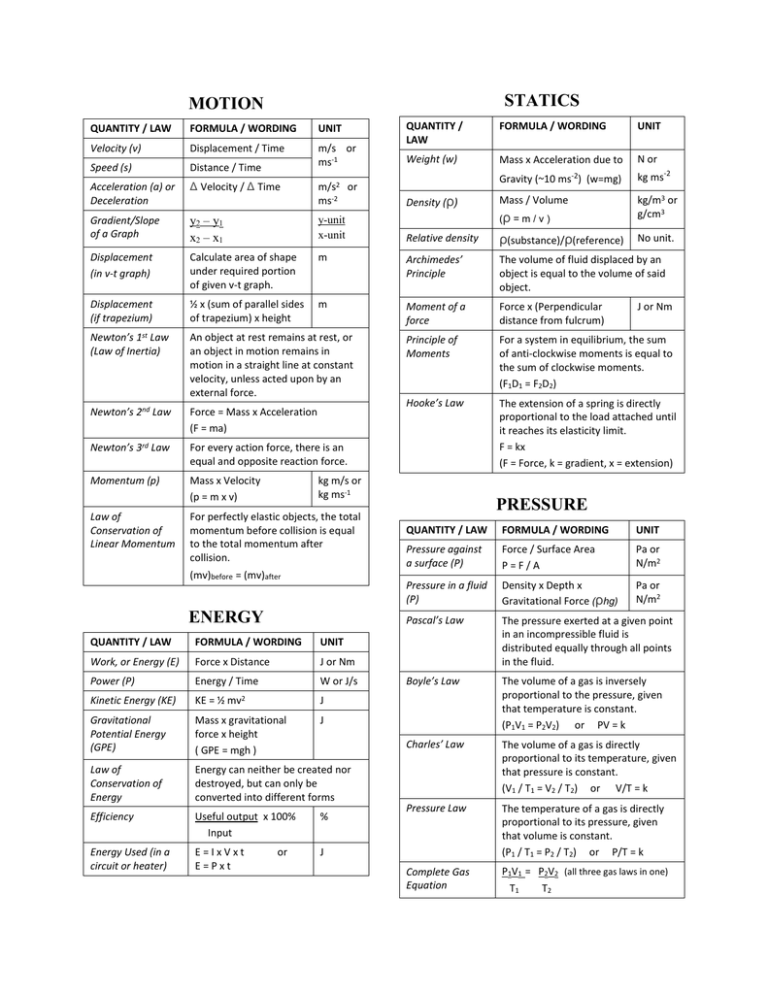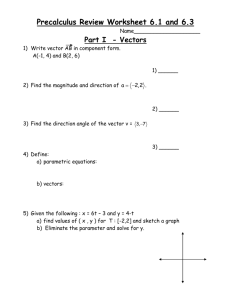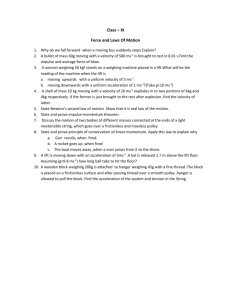Formulas - RPGMaker.net
advertisement

STATICS MOTION QUANTITY / LAW FORMULA / WORDING UNIT Weight (w) Mass x Acceleration due to N or QUANTITY / LAW FORMULA / WORDING UNIT Velocity (v) Displacement / Time Speed (s) Distance / Time m/s or ms-1 Acceleration (a) or Deceleration Δ Velocity / Δ Time Gradient/Slope of a Graph y2 – y1 x2 – x1 y-unit x-unit Relative density ρ(substance)/ρ(reference) No unit. Displacement (in v-t graph) Calculate area of shape under required portion of given v-t graph. m Archimedes’ Principle The volume of fluid displaced by an object is equal to the volume of said object. Displacement (if trapezium) ½ x (sum of parallel sides of trapezium) x height m Moment of a force Force x (Perpendicular distance from fulcrum) Newton’s 1st Law (Law of Inertia) An object at rest remains at rest, or an object in motion remains in motion in a straight line at constant velocity, unless acted upon by an external force. Principle of Moments For a system in equilibrium, the sum of anti-clockwise moments is equal to the sum of clockwise moments. (F1D1 = F2D2) Newton’s 2nd Law Force = Mass x Acceleration (F = ma) Hooke’s Law Newton’s 3rd Law For every action force, there is an equal and opposite reaction force. The extension of a spring is directly proportional to the load attached until it reaches its elasticity limit. F = kx (F = Force, k = gradient, x = extension) Momentum (p) Mass x Velocity (p = m x v) Law of Conservation of Linear Momentum For perfectly elastic objects, the total momentum before collision is equal to the total momentum after collision. m/s2 or ms-2 Density (ρ) (mv)before = (mv)after ENERGY QUANTITY / LAW FORMULA / WORDING UNIT Work, or Energy (E) Force x Distance J or Nm Power (P) Energy / Time W or J/s Kinetic Energy (KE) KE = ½ Mass / Volume kg/m3 or g/cm3 Gravitational Potential Energy (GPE) Mass x gravitational force x height ( GPE = mgh ) Law of Conservation of Energy Energy can neither be created nor destroyed, but can only be converted into different forms Efficiency Useful output x 100% Input % Energy Used (in a circuit or heater) E=IxVxt E=Pxt J J or Nm PRESSURE QUANTITY / LAW FORMULA / WORDING UNIT Pressure against a surface (P) Force / Surface Area P=F/A Pa or N/m2 Pressure in a fluid (P) Density x Depth x Gravitational Force (ρhg) Pa or N/m2 Pascal’s Law The pressure exerted at a given point in an incompressible fluid is distributed equally through all points in the fluid. Boyle’s Law The volume of a gas is inversely proportional to the pressure, given that temperature is constant. (P1V1 = P2V2) or PV = k Charles’ Law The volume of a gas is directly proportional to its temperature, given that pressure is constant. (V1 / T1 = V2 / T2) or V/T = k Pressure Law The temperature of a gas is directly proportional to its pressure, given that volume is constant. (P1 / T1 = P2 / T2) or P/T = k Complete Gas Equation P1V1 = P2V2 (all three gas laws in one) T1 T2 J or kg ms-2 (ρ = m / v ) kg m/s or kg ms-1 mv2 Gravity (~10 ms ) (w=mg) -2 J THERMODYNAMICS ELECTRICITY QUANTITY / LAW FORMULA / WORDING UNIT QUANTITY / LAW FORMULA / WORDING UNIT Specific Heat Capacity (c) The amount of heat 1kg of a substance can absorb before its temperature rises by 1K. (E = mcΔӨ) J/kg K or J kg-1 K-1 Voltage (V) a.k.a. p.d or e.m.f. V = IR V Power (P) P = VI Energy (E) E = IVt or E = P x t J Heat Capacity (C) Mass x Specific Heat Capacity J/K Resistance (series) (R) RT = R1 + R2 ... Ω Specific Latent Heat of Fusion (Lf) The amount of heat 1kg of a substance can absorb to convert it from a solid to liquid without changing its J/kg or J kg-1 Resistance (parallel) (R) 1=1+1 … RT R1 R2 Ω Charge (Q) Q=Ixt C Ohm’s Law The current in a wire is directly proportional to its p.d. (V = IR) Faraday’s Law A current in a coil can be induced by moving it through a magnetic field. Transformer (turns/coils) Np / N s = V p / V s Transformer (current) Vp Ip = Vs Is temperature. Specific Latent Heat of Vapourization (Lv) Kinetic Theory of Matter (E = mLf) The amount of heat 1kg of a substance can absorb to convert it from a liquid to gas without changing its temperature. (E = mLv) J/kg or J kg-1 When heated, the bonds between molecules break, causing the molecules to separate, move faster and also collide against surfaces more often, thus increasing pressure. WAVES / OPTICS QUANTITY / LAW FORMULA / WORDING UNIT Velocity (V) Frequency x Wavelength (V=fλ) m/s or ms-1 Frequency (f) No. of waves / Time Hz or s-1 Period of a wave (T) 1____ frequency s Two Laws of Reflection 1. The incident ray, reflected ray and normal all lie on the same plane. 2. The angle of incidence is equal to the angle of reflection. (Өi = Өr) Two Laws of Refraction 1. The incident ray, refracted ray and normal all lie on the same plane. 2. Snell’s Law, which is denoted by: n = sin i / sin r or n = sin r / sin i Refractive index (n)(given velocity) Velocity through air (c)_ Velocity through medium (v) Critical angle Өi when angle of refraction = Total internal reflection Occurs when the angle of incidence is greater than the critical angle. Magnification Size of image / Size of Object No unit. 90o or P = I2R W ...where, N = No. of Turns/Coils …where, p = primary, s = secondary ATOMIC PHYSICS Atomic Number No. of Protons Nucleon Number No. of Protons + No. of Neutrons Isotope An element with the same atomic no. of another but different mass no. Half-Life The amount of time it takes to half of a substance to radioactively decay. Energy gained in a nuclear reaction ΔE = Δmc2 (Einstein’s formula) Δm=change in mass, c= speed of light UNIT NOTATIONS PREFIX NOTATION Nano (n) 10-9 Micro (μ) 10-6 Milli (m) 10-3 Centi (c) 10-2 Kilo (k) 103 Mega (M) 106 K. HOSEIN – PHYSICS O’ LEVEL STUDY AID UPPER LEVEL EDUCATIONAL INSTITUTE




